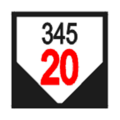Inclination pointer


Inclination pointers or inclination indicators on railways indicate the upward or downward gradient of the following section. Inclination pointers are particularly important in steam traction because the water level in the sight glass changes when the incline changes. Even with electric or diesel traction, they support the driver in regulating the tractive effort and braking force.
Square and older versions
The square boards with black corners at the top or bottom to represent a (white) arrow pointing up or down are used in Switzerland , the Czech Republic and Slovakia and until 1986 also in Austria . The capitalized number indicates the uphill or downhill gradient in ‰ , the lowercase number the length of the relevant section of the route in meters. Because the route refers to the horizontal , the train covers a slightly longer route until it has overcome the signaled section.
The inclination pointers of the older version point in the form of a bar diagonally upwards, downwards or horizontally, depending on whether the following section has an upward or downward gradient or is horizontal. There are various forms of older inclination pointers - including those that point like a signpost in the relevant direction, i.e. must be read when viewed across the direction of travel. Already in the 15th year of the Österreichische Eisenbahnzeitung it was criticized that these "cannot be seen in fog or very fast travel."
Switzerland
Changes in the incline of 2 ‰ and more can be signaled with inclination pointers to help the driver. On multi-lane routes , the inclination pointers are only set up on one side of the track structure.
Inclination pointer and below it meter table in Solis on the Albula line of the Rhaetian Railway (RhB).
Inclination indicator of the old design for a 96 ‰ gradient at the Stoss near the Appenzeller Bahnen (AB)
Earlier slope boards of the Seetalbahn
The Seetalbahn has many sharp changes in incline due to its route, which mainly runs alongside the road. The steep gradients are each short. For this route, special combined gradient and speed signs were developed that were not included in the 1947 signaling regulations.
The end signal was a reduced speed end signal with the additional black corners of a tilt pointer. The board was allowed to pass the Zugspitze at the following speed.
Depending on the row of trains, certain speed restrictions were assigned to each gradient , e.g. B .:
| Train row | 11 to 20 ‰ gradient | 21 to 30 ‰ gradient | 31 to 37 ‰ gradient |
|---|---|---|---|
| A 80 | 65 km / h | 55 km / h | 50 km / h |
| M 55 | 50 km / h | 40 km / h | 35 km / h |
With the introduction of the new operating concept in December 2002, in which tram regulations are sometimes used, these signs have been removed.
Slovenia
The same inclination pointers as in Switzerland can also be found in Slovenia at Slovenske železnice :
The following 99-meter-long portion after the station Bohinjska Bistrica the Wocheiner path has a slope of 15 ‰.
Czech Republic
On the Czech inclination pointers, the alcohol value of the uphill or downhill gradient is written in red. The design of the inclination pointers is based on the guidelines of the respective railway infrastructure company . In the case of the inclination pointers of the state SŽDC , the percentages are rounded. In the older versions, the levels 2.5 ‰, 5 ‰, 10 ‰ etc. occur. In the new designs, which can be recognized by the rounded corners, the inclines and slopes are rounded to multiples of 5 ‰, the lowest value being 10 ‰. The simplification led to a reduction in inclination pointers, which no longer indicate every incline change.
The following 363 meter long section in the Davle station on the Čerčany – Vrané nad Vltavou line has a gradient of 2.5 ‰.
The next 1371 meter long section from Jílové u Prahy towards Luka pod Medníkem has a gradient of around 20 ‰.
Previous uses
Germany
The German railways used rectangular inclination pointers to inform the locomotive personnel about the inclination of the route to be traveled at the time of steam operation. The slope was given with a fraction (ratio) instead of in ‰ as it is today . 1/909 stands for 1.1 ‰ gradient. The square inclination pointers of the Saxon Railways had a red border. Inclination pointers, albeit in a simplified form and without specifying the inclination ratio, were last included in the 1959 signal order .
Inclination pointer around 1900, exhibited in the Nuremberg Transport Museum
Saxon inclination pointer at the Windbergbahn, which indicates a gradient of 2.5 ‰.
Austria
Until September 27, 1986, the Austrian Federal Railways (ÖBB) also used inclination indicators, as they are still used in the Czech Republic today:
Inclination indicator of the Vienna Stadtbahn , preserved on the route of today's U6 .
Inclination pointer on the locomotive
Because inclination indicators are sometimes difficult to see along the route, reports are made early on about an inclination indicator that is "attached to the machine itself". A "4-5 long horizontal tube with a vertical arm at each end" and sight glasses worked like a hose level and promised to determine the incline of the route to within 1%. The condition is unaccelerated driving. Steam locomotives have to be heated according to the incline-dependent power requirement - and with as much foresight as possible in order to lose little speed uphill and, on the other hand, not to waste coal. Adding coal, throttling the supply air or blowing in by sucking off the exhaust gases with a steam jet in the conically widening chimney or topping up with water regulate the heat balance in the steam boiler.
literature
- Rudolf W. Butz: Signals of the Swiss Railways . Orell Füssli, Zurich 1972, ISBN 3-280-00080-7 , p. 94-97 .
References and comments
- ^ English language Wikipedia site Meitetsu Kakamigahara Line .
- ↑ a b Miniaturbahn.at. Retrieved September 13, 2014 (online shop).
- ↑ a b A new tilt indicator. - Austrian Eisenbahnztg., XV. Year, no. 37, p. 291. In: Messages from the daily literature of the railway industry . Issue 1 (January – February), 1893, pp. 20-21 ( archive.org ).
- ↑ a b Swiss Driving Regulations (FDV) A2016 Federal Office of Transport (FOT), July 1, 2016 (PDF; 3 MB). R 300.2, section 2.6.4 Inclination pointer
- ↑ Správa železniční dopravní cesty [SŽDC] (Ed.): Ordinance D1 . December 28, 1997 (Czech).
- ↑ a b Note on the inclination pointer exhibited in the Nuremberg Transport Museum
- ^ Matthias Hengst: True-to-scale track plans and buildings for Saxon narrow-gauge railways . Bufe-Verlag, Egglham 1993.
- ↑ Roland Smiderkal: Appendix: Abandoned signals. In: Austro-Swiss Railway Site. 2003, accessed September 27, 2014 .





















